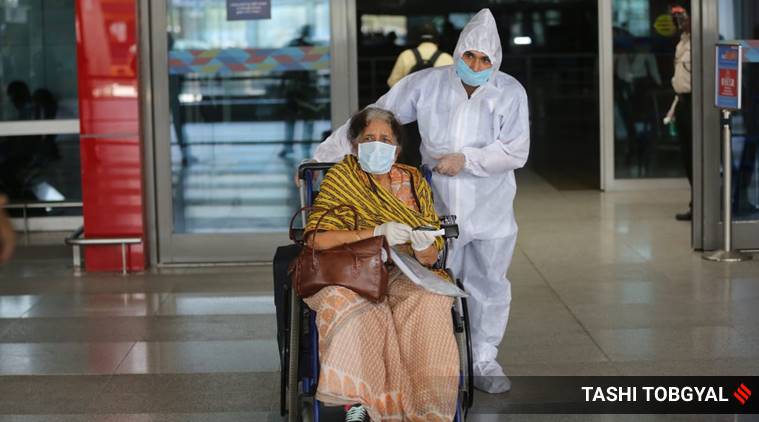
The Indian Express
To reinstall trust of diaspora in government as effective rescuer, a Citizen Evacuation Policy is needed
When the central government finally decided to offer a helping hand, it opted to launch a paid repatriation mission rather than an evacuation mission (which is free of cost for the evacuee). Is this the time to extract a pound of flesh from disheartened, disappointed and fatigued Indians?
by Jaiveer ShergillOn June 8, 2017, then External Affairs Minister of India, the late Sushma Swaraj, tweeted: “Even if you are stuck on Mars, the Indian Embassy will be there to help you.” This confidence-laden declaration to help Indians on foreign soil during crises stemmed from two factors. First, the glorious track record of 30-plus successful overseas evacuations by the government since Independence, including the Kuwait Airlift and Operation Safe Homecoming. These, despite being held during wartime conditions, were characterised by a quick governmental will and intent to shield the diaspora. Second, from the assurance given to every citizen on the first page of the Indian passport which reads “…Allow the bearer to pass freely… and to affirm him or her, every assistance and protection of which he or she may stand in need”.
COVID-19 has not only tested the resilience of the medical and safety infrastructure of the country but has also put to the test the seriousness of the pledge of assistance and protection made to every Indian travelling or studying abroad. While the reverse migration of labourers has exposed faultlines in the welfare apparatus, the commercialised, chargeable international missions — “Vande Bharat” and “Operation Samudra Setu” — expose the arbitrary and slow-footed response of the current central government towards the repatriation of Indians stuck abroad.
The government shut down Indian skies to all inbound traffic on March 22, which left a large number of Indians stranded in various countries. Indians marooned abroad stared at the bleak possibility of not returning home, faced evictions from hostels and hotels in certain cases due to safety measures as well as financial constraints. The sequence of events that followed, rather than reassuring them, gave the impression that the administration has a discriminatory and whimsical approach towards its citizens in need overseas. The decision to sign a contract whereby Air India would return safely the citizens of four countries — Germany, Canada, France and Ireland — and opting to fly back empty instead of ferrying back Indians (desirous of returning) left everyone with a sense of betrayal. The Ministry of External Affairs indulged in self-congratulation in one of its press briefings, for assisting 20,000 foreign nationals in exiting India. But it failed to share a blueprint or even give a commitment about the return of Indian citizens abroad, highlighting the “out of sight-out of mind” mindset of the decision-makers.
When the central government finally decided to offer a helping hand, it opted to launch a paid repatriation mission rather than an evacuation mission (which is free of cost for the evacuee). Is this the time to extract a pound of flesh from disheartened, disappointed and fatigued Indians? The Vande Bharat Mission along with Operation Samudra Setu has created history by being the largest paid repatriation exercise. It has also created history by being the most delayed and commercialised repatriation the world has seen in recent times.
Opinion | Migrants’ vulnerability is newly visible, but not new
More often than not, whenever the executive fails, the judiciary comes to the rescue. Unfortunately, in the case of stranded Indians, even the Supreme Court of India on April 13 said, “stay where you are” in an observation while dealing with the plea seeking directions to the government to initiate evacuation missions. The lacuna and unpredictability of the government’s response bring to the forefront the urgent need for India to have a well-structured and institutionalised rights-based “citizen evacuation policy” with the potential to be initiated and implemented without being held hostage to unpredictable political temperaments and the bureaucratic maze.
The fact that such a policy is critical for being well-prepared for another COVID-19 like exigency is a foregone conclusion. Also, keeping in mind the increasing traffic of outbound students, businessmen, tourists (the United Nations World Tourism Organisation estimated that more than 50 million Indians will travel abroad till 2022), researchers and job-seekers, India needs to revisit its overseas evacuation strategy. As suggested by a research paper on January 4, 2017,“India’s Expatriate Evacuation Operations: Bringing the Diaspora Home”, published by Carnegie India, legislators and policy experts need to frame a set of standard operating procedures. These must not be based on convenience but on the requirement to strengthen the response mechanism of Indian embassies worldwide (amongst other things) so that every Indian on foreign soil is aware of the law, timelines, communication channels, individual rights beyond the “11 line promise” printed on the first page of the passport. At the same time, the officials at the MEA need to answer why there was a departure from the swift, non-commercialised approach adopted in the past, creating a trust deficit amongst the help-seeking citizens.
Opinion | Migration: Some journeys are about choice, others are forced displacement
The Prime Minister of India, in a televised interview on January 21, 2018, claimed that the “Indian passport now has different respect and strength”. Now, just as the faith of migrant workers has been shaken and demolished by the system, the faith of students and tourists abroad stands scarred. To reinstall the trust of the diaspora in the government as an effective rescuer, a Citizen Evacuation Policy must be tabled at the earliest.
This article first appeared in the print edition on May 27, 2020 under the title ‘When faith is shaken’. The writer is a Supreme Court lawyer and national spokesperson, Indian National Congress